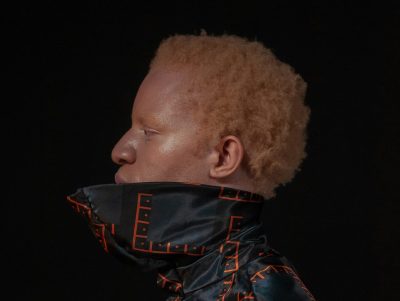‘Tiny’ Skin Mutation: Rethinking the Origins of Race Relations

Albinism (Image: Bamby Diagne on Unsplash)
One Mutation Away: Rethinking the Origins of White Skin
In 2005, scientists at Penn State University made a discovery that quietly shook the foundations of race-based thinking: a tiny genetic mutation, in just one letter of the human genome, could explain the first appearance of white skin in humans1.
Yes, you read that right—one single mutation. Out of 3.1 billion letters in our DNA, one small shift in the SLC24A5 gene is responsible for the light skin tones commonly found in Europeans today2. And this change didn’t happen in Africa—it occurred after some early humans migrated out of the continent.
For thousands of years, all humans had brown or dark brown skin. Melanin was nature’s armor, designed to protect us under the hot, radiant African sun. But when small groups journeyed north into colder, less sunny climates, survival demanded new adaptations. With less sun to trigger Vitamin D production, lighter skin offered a biological advantage. And so, by chance, one person—yes, just one—developed this mutation, passing it on through generations.
This is not just a science story. It’s a narrative reset.
From Mutation to Marginalization: A Social Lens
Now pause. Let’s imagine that day—tens of thousands of years ago—when that first child with pale skin appeared. Picture the shock. Perhaps the family felt shame or confusion. Maybe the community, unsure of what to do, ostracized the child. Just like twin children were once cast out in some ancient cultures, this white-skinned child might have faced rejection, ridicule, even threats.
What if that rejection shaped the child’s outlook? What if, over time, more children with the same condition appeared, and together they formed isolated groups—bonded by exclusion, survival, and necessity? That’s how a subculture is born. Not of superiority, but of pain and adaptation.
Some scientists speculate that sexual selection also played a role3. But maybe that wasn’t about attraction—it was about desperation. If no one in the mainstream wanted to marry them, they married each other.
What kind of worldview would emerge from such beginnings? One forged in rejection may lean into appearances—mastering surface-level perfection while quietly nursing deep-seated insecurity. It might prize individualism, polish, and control. Sound familiar?
Could this help explain some of the cultural paradoxes we see today—between collectivist, earth-centered indigenous societies and individualist, appearance-driven industrial cultures?
Could the emotional scars of ancient exclusion have evolved into:
-
A desire to dominate that which once rejected them?
-
A cultural obsession with aesthetics over substance?
-
A civilization built on exploitation masked as innovation?
From Blueprint to Mutation: The Afrocentric Reframe
Western narratives have long centered whiteness as the default, the pinnacle, the “ideal.” Meanwhile, Blackness was labeled “other,” even “deviant.” But now, armed with science and cultural truth, Afrocentric thinkers are reclaiming the story.
They remind us: Black is not a deviation—white is.
The entire concept of race, we now know, is biologically flimsy. Humans are more than 99.9% genetically identical4. Skin color? It’s skin-deep. Yet for centuries, a visible difference—born of a single mutation—was blown into a false hierarchy that shaped slavery, colonization, and systemic oppression.
Afrocentric scholars flip the script:
“Whiteness is not the origin—it’s the outlier.”
They’re not saying white skin is bad. They’re saying: stop pretending it’s the standard.
What Cultures Have Always Known
Even before this genetic revelation, many non-Western cultures revered dark skin and understood that whiteness wasn’t the only symbol of purity, beauty, or power.
-
In Japan, black (kuro) signifies nobility and seniority.
-
The Maasai of Kenya associate black with rain clouds, and life.
-
Hinduism calls Krishna “the black one”—a deity.
-
In much of Africa and Asia, white is the color of death and mourning.
-
In Shotokan karate, the white belt symbolizes the lowest rank5.
Meanwhile, in Western societies, whiteness became tethered to power structures. Over time, skin color morphed into social status, and a single mutation was weaponized into myths of racial superiority.
The Truth in the Genome
Study leader Dr. Keith Cheng was cautious. He feared the discovery might be misused to revive old racist tropes. But what this science actually reveals is liberating:
Skin color is not a marker of intelligence, worth, or capability. It’s a biological response to environment.
And even more profoundly, the mutation that created white skin is so minuscule, it exposes the absurdity of racism.
Vivian Ota Wang of the National Human Genome Research Institute put it well:
“You may tell people that race isn’t real and doesn’t matter, but they can’t catch a cab”6.
Reclaiming the Narrative
This is more than a science headline. It’s a cultural wake-up call. It’s a chance for Africa and her diaspora to reclaim identity with pride and perspective.
Blackness is not a stain. It’s the source. It’s not what went wrong—it’s what came first.
And as for that tiny mutation? It created diversity, yes. But it also created confusion, conquest, and centuries of miseducation.
Let’s rewrite the story.
Instead of shaming the original, let’s honor the blueprint. And maybe, just maybe, begin the long road to reconciliation—with truth, not lies, as our compass.
#Feelnubia #AfrocentricTruth #ReclaimingBlackness #SkinDeep #GeneticsAndRace
Footnotes
If you enjoyed this article, you might enjoy these: The Missing Black Populations of North Africa, Reconstructing Black, Africa’s 600-year-old Chinese fable
